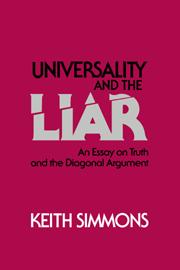Book contents
- Frontmatter
- Contents
- Preface
- Chapter 1 The Liar paradox
- Chapter 2 The diagonal argument
- Chapter 3 The diagonal argument and the Liar, I
- Chapter 4 The diagonal argument and the Liar, II
- Chapter 5 A medieval solution to the Liar
- Chapter 6 A singularity solution to the Liar
- Chapter 7 A formal account of singularities
- Chapter 8 Applications and further singularities
- Chapter 9 Semantic universality
- Notes
- Bibliography
- Index
Chapter 5 - A medieval solution to the Liar
Published online by Cambridge University Press: 19 October 2009
- Frontmatter
- Contents
- Preface
- Chapter 1 The Liar paradox
- Chapter 2 The diagonal argument
- Chapter 3 The diagonal argument and the Liar, I
- Chapter 4 The diagonal argument and the Liar, II
- Chapter 5 A medieval solution to the Liar
- Chapter 6 A singularity solution to the Liar
- Chapter 7 A formal account of singularities
- Chapter 8 Applications and further singularities
- Chapter 9 Semantic universality
- Notes
- Bibliography
- Index
Summary
According to Diogenes Laertius, the Liar was authored by Eubulides in the 4th century B.C. Little is known of ancient solutions. Aristotle appears to treat it as a fallacy secundum quid et simpliciter; Chrysippus seems to have held that the Liar sentence has no meaning at all; other treatments are alluded to in three entries of Diogenes' catalogue of the writings of Chrysippus.
In contrast, the medieval insolubilia literature is a very rich source of attempts to solve the Liar. Some of these resolutions are primarily influenced by Aristotle and attempt to force insolubilia into the mold of one or other of several fallacies laid out by Aristotle in Sophistical Refutations. Other solutions are distinctively medieval. Still others anticipate, to varying degrees, modern approaches. There are clear anticipations of the following modern views: the Liar sentence is not grammatically well-formed; the Liar sentence, though well-formed, does not express a proposition; the Liar sentence is neither true nor false, but suffers a truth-value gap, or else receives a third truth value; and, finally, restrictions are to be placed on self-reference. Further, it is arguable that there are medieval anticipations of Tarski's solution via a hierarchy of languages, of Russell's type theory and his vicious circle principle, and of the view that Liar sentences are both true and false.
In this chapter, I examine one medieval resolution of the Liar. I shall argue that this resolution has not been adequately captured by modern commentators.
- Type
- Chapter
- Information
- Universality and the LiarAn Essay on Truth and the Diagonal Argument, pp. 83 - 98Publisher: Cambridge University PressPrint publication year: 1993



